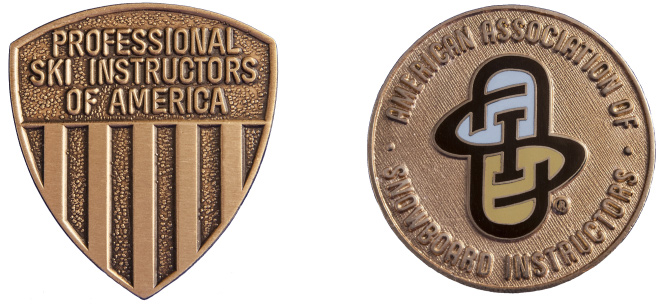(This article by Tera Adams appears in the Fall 2021 Issue of 32 Degrees; for other great stories you can read the full issue online.)
One memory stands out from when I took my AASI Level I exam at Utah’s Brighton Resort over 10 years ago; it wasn’t just a memorable moment for the day, it was a pivotal moment in my life. It’s when I learned the value of taking the challenging line.
When the examiner started the freeride portion of the exam, he pointed to a set of trees he wanted us to ride. I hung back, traversed deeper into the trees, and then dropped. I had fun, sometimes pausing to reassess my line, and when I reentered the trail I was quite a bit lower than the rest of the group
For a second I felt a little bummed, thinking I was slower and less skilled than the other riders. The examiner asked the group to head to the nearby chairlift and then slid down to me to share something that has stuck with me all these years. He said, “You might not have been the fastest in the group, but you sure picked the hardest line… and you nailed it.”
Looking back, I’ve realized my examiner summed up my life and career path perfectly. I had so much fun in those woods, and picking the difficult line was definitely worth the challenge.
Stepping up to the Challenge
Fast forward to last season when I decided to take the hard line again – specifically, going for my Freestyle Specialist 1 credential. Freestyle is not my “jam.” Give me a mediocre day in the trees over the best park conditions any day. I’m not excited to take laps in the park, and if I am going to spend hard-earned dollars on an event, it’s not going to be a freestyle event… or so I thought.
I decided to take the hard line and applied for the PSIA-AASI Certification or Specialist Track Scholarship. When I received the scholarship, I registered for my Freestyle 1 exam.
In the Park, and Outside My Comfort Zone
The two-day exam was not easy. We had gnarly weather (fog, thunder, lightning, rain, and sleet), and the visibility was so bad it was hard to see the features. But it was a great challenge, and I realized I could build a life metaphor from the National Ski Area Association’s SMART Style code. If you’re unfamiliar with the code, it’s an acronym skiers and riders follow in the park.
SMART Style Code
Start Small – Work your way up. Build your skills.
Make a Plan – Every feature. Every time.
Always Look – Before you drop.
Respect – The features and other users.
Take it easy – Know your limits. Land on your feet.
For fun, I adapted NSAA’s SMART Style code into an acronym for life. Here it is…
SMART-FOR-LIFE Code
Start small – But dream big.
Make a plan – And work toward your goals.
Always look – Look to others for ideas and inspiration.
Respect the features and other users – And respect the process.
Take risks – (Yes, I changed this one.) Grow your limits and work hard to land on your feet.
Here’s how you can use the code to prepare for your next certification assessment:
Start small – But dream big.
Break down the assessment into smaller skills that link up to meet the standards. Work on understanding the fundamentals, body movements, and board/ski performance and how they relate to each other.
Make a plan – And work toward your goals.
Figure out what you need to accomplish your goals. Is it training? Is it finances? (Don’t forget division and national scholarships.) Is it time off to attend events? (Talk to your supervisor and managers about your schedule early in the season.) What is it that you need to succeed?
Always look – Look to others for ideas and inspiration.
Find a mentor, look to your peers as sources of learning, and, when possible, help encourage or serve as a mentor for another instructor.
Respect the features and other users – And respect the process.
The world of snowsports is not always easy, and that’s okay. Sometimes we crash, and that’s okay. We’re learning. Sometimes the process of learning is messy and exhausting, and that’s okay. Sometimes we fail, it could be at a maneuver or at an exam, and that’s okay. Failure highlights where we still have opportunities to grow as humans and as professionals.
Take risks – Grow your limits and work hard to land on your feet.
You never succeed if you never try. Push your comfort zone. Show up with all of yourself. Be ready to learn. Work hard. Be willing to fail. It’s always worth the effort.
So… what do you want to accomplish this season? Be SMART about it and enjoy the ride.
__
Tera Adams is the program director at Adaptive Sports at Vermont’s Mount Snow. Her snowsports teaching credentials include Snowboard Level II, Adaptive Snowboard Level II, Adaptive Alpine Level II, Alpine Level I, Telemark Level I, Children’s Specialist 2, and Freestyle Specialist 1.

